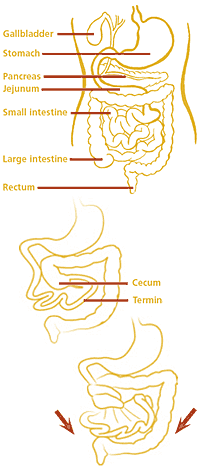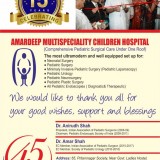What is malrotation?
Malrotation is an abnormality of the bowel, which happens while the baby is developing in the womb.
Early in pregnancy, the bowel is a long straight tube leading from the stomach to the rectum. The bowel then moves into the umbilical cord temporarily while it develops into the large and small bowel.
Around the tenth week of pregnancy, the bowel moves back into the abdomen and coils up to fit into the limited space there. If the bowel does not coil up in the correct position, this is called malrotation.

What is volvulus?
This is a complication of malrotation and occurs when the bowel twists so the blood supply to that part of the bowel is cut off.
What are the symptoms of malrotation and volvulus?
Malrotation may not have any symptoms. Many people are never diagnosed with malrotation because it causes no problems. However, bands of tissue (adhesions), which block the first part of the small bowel (duodenum), can develop. This means food cannot easily pass through the duodenum to the rest of the bowel for digestion.
The symptoms of volvulus are usually the first sign of malrotation. They include sudden bouts of crying and pulling the legs into the body, which then stop suddenly. This is caused by cramps, as the bowel cannot push food and liquid past the twisted section of bowel. Vomiting is another symptom of volvulus, as your child is unable to digest food as usual.
If the condition is not treated, the child will become dehydrated which can be life-threatening. the symptoms of dehydration may appear in phases, and include lethargy and reduced urine output.
What causes malrotation and volvulus and how common are they?
We do not know exactly what causes malrotation and volvulus, but it is not due to anything that happened during pregnancy. Malrotation affects about one in every 2,500 to 3,000 babies, and boys and girls in equal numbers.
How is malrotation and volvulus diagnosed?
Malrotation and volvulus are usually diagnosed using x-rays. A barium x-ray may also be useful as it shows the feeds being unable to pass the twisted part of the bowel. The doctor may also suggest an ultrasound scan to get an indirect evidence.
How are they treated and are there any alternatives?
Adhesions and volvulus are usually treated in an operation under general anaesthetic. They both require emergency treatment as the bowel can die off from lack of blood-supply, which would stop it functioning properly and can also lead to problems with infection. The effects of the adhesions and volvulus, like dehydration due to the lack of fluids being absorbed, can become serious quite quickly in children, and so there are no alternatives to the operation.
What happens before the operation?
If your child is dehydrated, he or she will need a ‘drip’ of fluids for a while before the operation. Your child will also need a nasogastric tube, which is passed up the nose, down the food-pipe and into the stomach. This will drain off the stomach and bowel contents and ‘vent’ any air that has built up, which will make your child more comfortable.
What does the operation involve?
The operation is called a Ladd procedure. The surgeon will straighten out the twisted bowel and separate any adhesions. If the bowel looks healthy, the surgeon will coil it back into the abdomen. Usually the surgeon will also remove the appendix during this operation, as it is often on the wrong side of the body in malrotation, which could cause problems in diagnosing appendicitis later in life.
In a complicated condition the surgeon will remove any parts of the bowel where tissue has died. The amount can vary, but the surgeon will leave as much of the bowel as possible. If the surgeon has to remove a large part of the intestine, he or she may need to create an artificial way of disposing of waste matter, called a ‘stoma’.
Are there any risks?
All surgery carries a small risk of bleeding during or after the operation. Every anaesthetic carries a risk of complications, but this is very small. Your child’s anaesthetist is an experienced doctor who is trained to deal with any complications.
What happens afterwards?
For the first few days, your child will need to be fed through a tube into his or her veins so the stomach and bowel can start to heal. After a while, you can start to feed your child again, starting with small amounts, and increasing the amount as he or she tolerates it.
When you go home
The stitches used during the operation will dissolve on their own so there is no need to have them removed. If possible, keep the operation site clean and dry for two to three days to let the operation site heal properly. If your child needs to have a bath, do not soak the area until the operation site has settled down.
What is the outlook for children with malrotation and volvulus?
The outlook depends on how quickly the malrotation and volvulus are diagnosed as this in turn can influence the amount of damage to the bowel.




